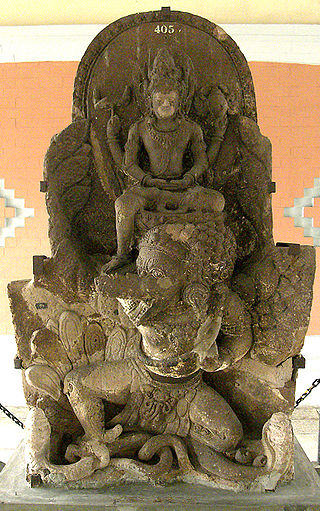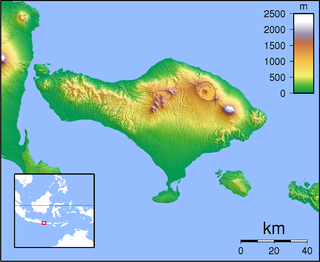Related Research Articles

The Mataram Kingdom ; also known as Medang Kingdom was a Javanese Hindu–Buddhist kingdom that flourished between the 8th and 11th centuries. It was based in Central Java, and later in East Java. Established by King Sanjaya, the kingdom was ruled by the Shailendra dynasty and Ishana dynasty.

Airlangga, regnal name Rakai Halu Sri Lokeswara Dharmawangsa Airlangga Anantawikramottunggadewa, was the only king of the Kingdom of Kahuripan.
Ananggawarman was a crown prince (yuvaraja) of the Malayapura kingdom, which ruled at the end of the 14th century. The Malayapura kingdom was centered on the Minangkabau Highlands and its territory covers much of central Sumatra. The name Ananggawarman is inscribed on Saruaso II inscription as the son of King Adityawarman. It is not clear when Ananggawarman began to reign in place of his father, but it was written in the History of Ming that the kingdom sent a messenger again to China in 1376.
Sri Maharaja Rakai Watukura Dyah Balitung Sri Dharmodaya Mahasambu was the king of the Kingdom of Mataram. He reigned circa 899–911. His territories included Central Java, East Java, and Bali.

The History of Bali covers a period from the Paleolithic to the present, and is characterized by migrations of people and cultures from other parts of Asia. In the 16th century, the history of Bali started to be marked by Western influence with the arrival of Europeans, to become, after a long and difficult colonial period under the Dutch, an example of the preservation of traditional cultures and a key tourist destination.

Sri Kesari Warmadewa was the first king of Bali whose name is recorded in a written inscription. He was the issuing authority for four inscriptions, including the famous 914 CE inscription on the Belanjong pillar in southern Sanur.

The Warmadewa dynasty, also Varmadeva dynasty, was a regnal dynasty on the island of Bali.
Udayana Warmadewa, also Dharmmodayana Warmadewa, was a king of the island of Bali in the 10th century. He belongs to the Warmadewa dynasty. He was married to the Javanese queen Mahendradatta, also known as Gunapriyadharmapatni. Their son was the famous Airlangga, who replaced the overthrown emperor of Java Dharmawangsa, and ruled in both Java and his original home of Bali. Mahendradatta and Udayana co-ruled Bali, issuing inscriptions in both their names.

The Belanjong pillar, also Blanjong pillar or Blanjong inscription, is a pillar established in 914 CE in the harbour of Belanjong, in the southern area of Sanur in Bali.
Mahendradatta, also known as Gunapriya Dharmapatni, was the queen of Bali and wife of Udayana Warmadewa, also popularly known as King Udayana from Warmadewa dynasty. She was also the mother of Javanese hero-king Airlangga. Mahendradatta and Udayana co-ruled Bali, issuing inscriptions in both their names. Her other younger sons are Marakata and Anak Wungçu.
Dara Jingga, was one of the Malay Dharmasraya princess who was intended to be betrothed to Javanese King Kertanegara of Singasari after the Pamalayu expedition 1275–1293.

The Kingdomship of Bali was a series of Hindu-Buddhist kingdoms that once ruled some parts of the volcanic island of Bali, in Lesser Sunda Islands, Indonesia. With a history of native Balinese kingship spanning from the early 10th to early 20th centuries, Balinese kingdoms demonstrated sophisticated Balinese court culture where native elements of spirit and ancestral reverence combined with Hindu influences – adopted from India through ancient Java intermediary – flourished, enriched and shaped Balinese culture.

Kudungga was the founder of the Kutai Martadipura kingdom who ruled around the year 350 AD or 4th century AD. Kudungga first ruled the kingdom of Kutai Martadipura as a community leader or chieftain. Kutai Martadipura during Kudungga rule do not have a regular and systematical system of governance. In contrary, the latest claim is said that Maharaja Kudungga is possibly a king from ancient kingdom Bakulapura in Tebalrung , and Asvavarman which his son-in-law rather his son, then become the first king of Kutai Martadipura.
Śri Wijaya Mahadewi of Bali, was a queen regnant of the Kingdom of Bali in 983-989.
Isyana stylized as Sri Isyana Tunggawijaya was a queen regnant of Mataram Kingdom, in East Java, that ruled since 947 CE. She co-reigned with her spouse, Sri Lokapala. The Isyana dynasty, established by her father, Mpu Sindok that ruled Java circa the 10th century CE, was named after her.
Sri Makutawangsa Wardhana was the king of Mataram Kingdom, in East Java, that ruled prior to 990s CE. He was the son and the successor of Queen Isyana Tunggawijaya and King Sri Lokapala. He belongs to the Isyana dynasty, established by his grandfather, Mpu Sindok that ruled Java circa the 10th century CE.
Sang Ratu Aji Tabanendra Warmadewa was a king from the Warmadewa dynasty, who is thought to have ruled in Bali between 877-889 Saka. His name is mentioned on three inscriptions in Manik Liu village, dated the 1st of Srawana month in the year of 877 Saka; and in another inscription in Kintamani village, dated the 6th of Bhadrapada month, Suklapaksa in the year of 889 Saka.
Sang Ratu Sri Janasadhu Warmadewa was a king of the Warmadewa dynasty, who ruled Bali around the end of the 10th century CE. Based on various inscriptions, he was the fifth king of the dynasty. King Janasadhu's name has been found in only one inscription, namely the Sembiran inscription, which was dated to 897 Saka.
Makata Pangkaja was a Balinese king from the Warmadewa dynasty.

Sri Maharaja Rakai Kayuwangi Dyah Lokapala Sri Sajjanotsawatunggadewa was the seventh monarch of the Mataram Kingdom of Central Java period who ruled between 856 and 885. He is commonly known as Dyah Lokapala, King Lokapala, or Rakai Kayuwangi. King Lokapala was described as a valiant king that defeated his enemies.
References
- Poesponegoro, Marwati Djoened; Notosusanto, Nugroho (2008). Sejarah Nasional Indonesia II: Zaman kuno (in Indonesian). PT Balai Pustaka. ISBN 9789794074084.
- Setiawan, I Ketut (2008). Brigitta Hauser-Schäublin, I Wayan Ardika (ed.). "Socio-Political Aspect of Julah". Burials, Texts and Rituals: Ethnoarchaeological Investigations in North Bali, Indonesia. Bali: Universitätsverlag Göttingen. doi: 10.17875/gup2019-1239 . ISBN 9783940344120.
- Shastri, Narendra Dev. Pandit (1963). Sejarah Bali Dwipa (in Indonesian). Denpasar, Bali: Bhuana Saraswati.